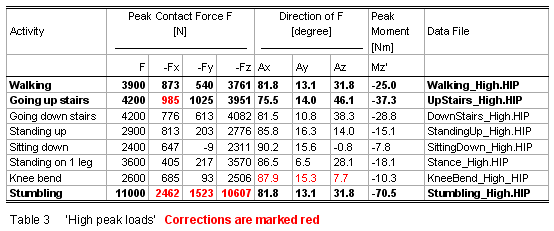Standard Loads Hip Joint
Standard Loads Hip Joint
From the hip joint forces and activity numbers of the most frequent activities of daily living (contained in HIP98) standardized and simplified load scenarios were derived. They are aimed at being applied in experimental or analytical tests on the stability of hip implants and their fixation in bone.
The following data files with average and maximum forces are available: Walking, going up stairs, going down stairs, sitting down, standing up, standing and stumbling.
Most decisive for strength and fixation are the following activities
Average loads: Walking and going up stairs
Maximum loads: Walking, going up stairs and stumbling
All data files can be downloaded in this zip-file: Standard Tests Hip Joint (58 kB)
A detailed description of applicable test conditions is published in [G. Bergmann et al., 2010].
In Table 3 of this paper some numbers are erroneous. This is the corrected table:

Realistic loads for testing hip implants.
Bergmann G, Graichen F, Rohlmann A, Bender A, Heinlein B, Duda GN, Heller MO, Morlock MM.
Biomed Mater Eng. 2010;20(2):65-75
Abstract.
The aim here was to define realistic load conditions for hip implants, based on in vivo contact force measurements, and to see whether current ISO standards indeed simulate real loads. The load scenarios obtained are based on in vivo hip contact forces measured in 4 patients during different activities and on activity records from 31 patients. The load scenarios can be adapted to various test purposes by applying average or high peak loads, high-impact activities or additional low-impact activities, and by simulating normal or very active patients. The most strenuous activities are walking (average peak forces 1800 N, high peak forces 3900 N), going up stairs (average peak force 1900 N, high peak forces 4200 N) and stumbling (high peak forces 11,000 N). Torsional moments are 50% higher for going up stairs than for walking. Ten million loading cycles simulate an implantation time of 3.9 years in active patients. The in vitro fatigue properties of cementless implant fixations are exceeded during stumbling. At least for heavyweight and very active subjects, the real load conditions are more critical than those defined by the ISO standards for fatigue tests.



